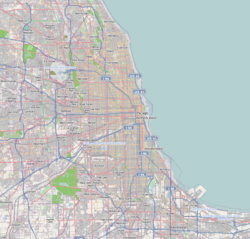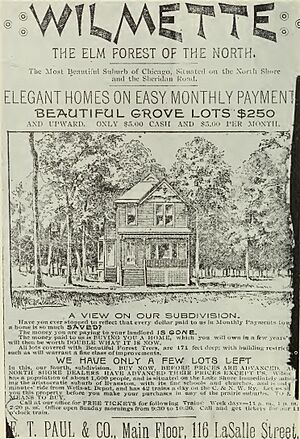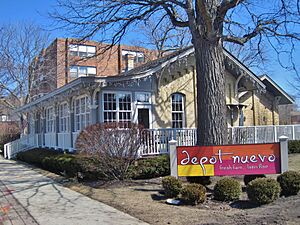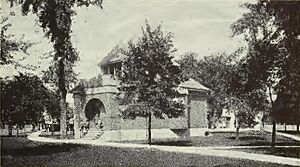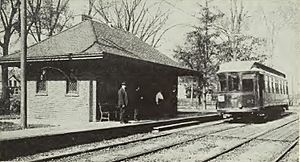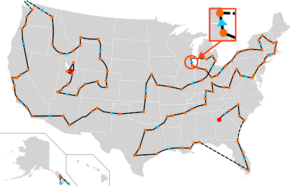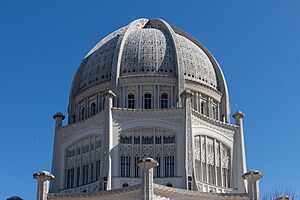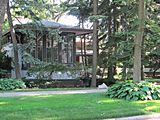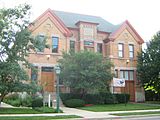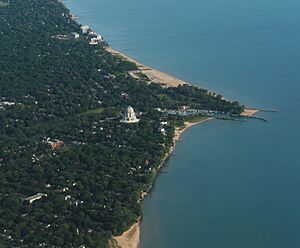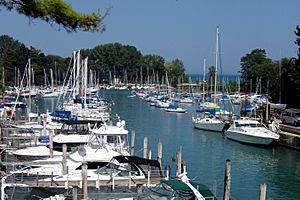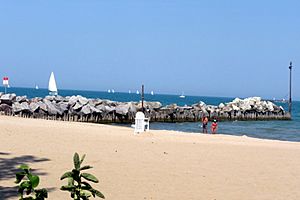Wilmette, Illinois facts for kids
Quick facts for kids
Wilmette, Illinois
|
||
|---|---|---|
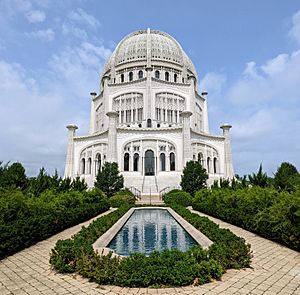
|
||
|
||
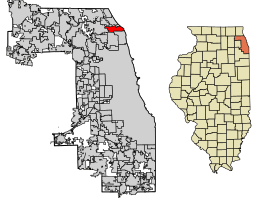
Location of Wilmette in Cook County, Illinois
|
||
| Country | United States | |
| State | Illinois | |
| County | Cook | |
| Township | New Trier Township | |
| Founded | 1872 | |
| Area | ||
| • Total | 5.41 sq mi (14.01 km2) | |
| • Land | 5.40 sq mi (13.99 km2) | |
| • Water | 0.01 sq mi (0.02 km2) | |
| Elevation | 636 ft (194 m) | |
| Population
(2020)
|
||
| • Total | 28,170 | |
| • Density | 5,215.70/sq mi (2,013.63/km2) | |
| Standard of living (2015–19) | ||
| • Per capita income | $87,576 | |
| Time zone | UTC−6 (CST) | |
| • Summer (DST) | UTC−5 (CDT) | |
| ZIP Code |
60091
|
|
| Area code(s) | 847 and 224 | |
| FIPS code | 17-82075 | |
| Wikimedia Commons | Wilmette, Illinois | |
Wilmette is a village in Cook County, Illinois, United States. It sits right next to Lake Michigan and is about 14 miles (22.5 km) north of Chicago's downtown area. In 2020, about 28,170 people lived here. Wilmette is famous for being home to the only Baháʼí House of Worship in North America. It also has excellent schools, with Central Elementary and Romona Elementary recently winning the National Blue Ribbon award from the U.S. Department of Education.
Contents
History of Wilmette
How Wilmette Began
Early Days and Native Americans
Long ago, Wilmette was a forest with tall cliffs along the lake. The Potawatomi tribe lived here before European settlers arrived. Sadly, Native Americans were forced to leave the area in the 1820s and 1830s.
The Ouilmette Family
The village is named after Archange and Antoine Ouilmette. Archange was born around 1781 and was part Potawatomi. She married Antoine Ouilmette, a French-Canadian fur trader. They were among the first people to live in Chicago.
In 1829, the U.S. government gave Archange 1,280 acres (5.2 sq km) of land in what is now Wilmette and Evanston. The Ouilmettes built a cabin and lived on this land. Later, they moved to Iowa, and their children eventually sold the land.
First Settlers After the Ouilmettes
After the Ouilmette family left, many farmers settled in the area. In the 1850s and 1860s, more wealthy people from the East Coast bought land here.
The Chicago and Milwaukee Railroad tracks were built in 1855. This helped more people move to the North Shore area. Landowners in Wilmette offered to pay for a train station if the railway would stop there. The railway agreed, and train service to Wilmette began in 1869. The first station burned down, but a new one was built by 1874. This building is still around today!
In 1871, Central School, the first public school, opened in a one-room building. Wilmette officially became a village on September 19, 1872. John Westerfield, who owned a large farm, was elected the first village president.
Gross Point Village
A part of Wilmette, especially the western side, used to be a separate community called Gross Point. German-speaking Roman Catholic farmers settled here in the late 1830s. They named their village Gross Point in 1874.
St. Joseph Roman Catholic Church was built in 1845. The church opened a school in 1873. Gross Point was known for its many taverns along Ridge Road, which caused some disagreements with nearby towns like Evanston.
In 1897, Gross Point opened its own small public school. The building for this school later became home to the American Legion Post 46.
Wilmette in the 1890s
By the early 1890s, the Chicago & Milwaukee Railroad had two tracks in Wilmette. In 1890, Wilmette built its first village hall. The village also started getting treated water from Evanston and set up telephone service. In 1895, the Wilmette Public Works Department was created to take care of the village's roads and other services.
The Chicago, North Shore and Milwaukee (North Shore Line) began train service in Wilmette in 1899. Its route through Wilmette is now part of the 9-mile Green Bay Trail.
People in Wilmette enjoyed social and literary clubs. The Wilmette Woman's Club, started in 1891, did many good things for the community.
Some people wanted Wilmette to join Evanston because Evanston had better fire, police, and water services. However, votes to join Evanston failed. After this, Wilmette improved its own services, building a central fire station in 1899 and paving streets with bricks. New Trier High School, which serves students from Wilmette, opened in 1901.
New schools were built as Wilmette grew. In 1892, a new brick building was constructed for Central School. Logan School opened in 1893 and later became McKenzie Elementary School.
The 20th Century
Early 1900s Growth
Sheridan Road opened in 1900, making it easier for cars to travel along the lakeshore.
In 1900, Wilmette residents voted to create a free public library. With help from Andrew Carnegie, a new library building was built in 1905.
The North Shore Channel, which ends in Wilmette, was a big project to help manage Chicago's sewage. When it was built, it created new land from the dirt that was dug up. In 1908, Wilmette residents voted to create a Park District to take care of this new land. This land became much of today's Gillson Park. The North Shore Channel project, finished in 1909, also created Wilmette Harbor.
Wilmette's first informal beach opened in 1910. In 1914, an official swimming beach was set up at the site of today's Gillson Beach, with changing rooms and other facilities.
In 1912, the Northwestern Elevated Railroad (now the Chicago Transit Authority Purple Line) extended its service into Wilmette. Two new stations, Isabella and Linden, were built. Linden became the end of the line.


More than 400 men from Wilmette and Gross Point Village served in World War I. Many women volunteered with the American Red Cross Auxiliary. By 1918, Wilmette's population had grown to 5,000 people.
Wilmette in the 1920s
Between 1900 and 1920, Wilmette's population more than tripled. In 1922, the village made a "Plan of Wilmette" to guide its future growth.
In 1919, the nearby Village of Gross Point went bankrupt and was later joined with Wilmette in 1924 and 1926.
Construction began on the Bahá'í House of Worship in 1920. It took many years to finish, finally opening in 1953.
The Sheridan Shore Yacht Club opened in Wilmette Harbor in the 1920s. It was first located in the large mansion of architect Benjamin Marshall. This mansion was very fancy, with many rooms, a tropical greenhouse, and rare art.
New neighborhoods like 'Indian Hill Estates' began to be built in 1926, with winding roads and large homes.
The Great Depression Era
During the Great Depression, Universal Oil Products co-founder Carbon Petroleum Dubbs became Village President in 1931. He helped Wilmette avoid bankruptcy by cutting the budget. In 1934, Wilmette opened its own water plant, which was a big achievement during tough times. By 1938, Wilmette was even selling water to Glenview.
The Works Progress Administration (WPA) helped Wilmette during the Depression. They resurfaced brick streets and fixed the Wilmette pier. Another WPA project built a lakefront amphitheater at Gilson Park, now called the Wallace Bowl.
In 1931, Green Bay Road opened, providing another main road through the area. A Coast Guard station was also set up in Wilmette Harbor in 1931.
The Depression slowed down home building, but new, more modest homes were built in the mid-1930s. The 'Kenilworth Gardens' and 'Indian Hills Estates' neighborhoods continued to grow.
World War II Era
During World War II, life in Wilmette focused on supporting the war effort. People held bond drives, air raid drills, and scrap drives. The Wilmette Council of Civil Defense organized classes to train citizens in first aid and fire-fighting. Eighty-three service members from Wilmette died during the war.
The Wilmette Coast Guard Station had a lot more work during the war. Volunteers from the Wilmette Coast Guard Auxiliary helped out.
In 1942, after a long legal process, Wilmette officially took over "No Man's Land," an area to its north.
In 1943, a ship called the USS Wilmette carried President Franklin D. Roosevelt and other leaders to plan strategies for World War II. This ship was originally the SS Eastland, a passenger ship that had a tragic accident in 1915, causing 884 deaths.
Postwar Growth
After World War II, there was a big need for homes. This led to a building boom in the 1950s, especially west of Ridge Road. Farmland turned into new neighborhoods with ranch-style and bi-level houses. Wilmette's population grew from 18,162 in 1950 to 28,268 ten years later.
The Edens Expressway opened in 1951, and the Carson Pirie Scott department store opened the Edens Plaza shopping center next to it in 1956.
Youth sports also grew. The Wilmette Baseball Association started in 1951, and by 1962, it had over 900 young players, including famous actor Bill Murray.
In 1951, the Wilmette Public Library built a new facility. The North Shore Line train service stopped in Wilmette in 1955.
In 1968, the Curtis Curling Center, a modern curling facility, opened thanks to a donation.
Village Centennial and National Bicentennial
Wilmette celebrated its 100th birthday in 1972 with parties at Village Hall.
In 1972, Centennial Park opened. The Park District had bought land for it since 1967. Voters approved plans for a sports complex at Centennial Park, which was completed in 1972 with a public swimming pool and indoor tennis courts. In 1974, an indoor ice complex was added, opening as Centennial Ice Center the next year.
A large farm, the last one in the village, was part of the land for Centennial Park. The Park District allowed the farmer to stay until his death in 1978. This marked Wilmette's change from a farming town to a busy suburb.
In 1972, Northwestern University offered to sell its 106-acre golf course. Citizens voted to buy it to keep it as open land, and the Wilmette Park District acquired it.
In 1973, the Chicago Transit Authority stopped service at the Isabella station, making Linden Station the only CTA station in Wilmette. In 1974, Wilmette started its own bus system called Wilbus.
The old 1897 train station building was saved from being torn down in 1974 and moved to a new location. It is now a local landmark. In 1975, a new train station was built, and the 1874 station was removed for parking.
A new Village Hall was built from 1973 to 1975. Its dedication ceremony was held on Independence Day in 1976, the bicentennial year for the U.S.
Late 20th Century
In 1978, the Curtis Curling Center closed due to money problems. It was later turned into a senior housing complex in 1982.
In the 1970s, fewer children were in primary school, so Wilmette closed three schools, including Bell School. Highcrest Middle School was also closed but kept for future use. It was later used as a community recreation center and the Wilmette Historical Museum.
The Green Bay Trail opened in 1981, offering a path for walking and biking.
In 1991, construction began on a new Linden Station building, which opened in 1993. The old station was saved and became a retail space.
In 1995, Pace took over Wilmette's local bus routes, ending the Wilbus service.
In 1994, Highcrest Middle School reopened. The Wilmette Park District moved to the former Bell Elementary School building, which became the Community Recreation Center in 1995. This center has spaces for young children, seniors, a fitness club, and a gymnastics facility. An athletic gym was added in 1996, and an auditorium in 1998.
The 21st Century
In 2000, residents voted to spend money to rebuild the pools at Centennial Park. The new pools reopened in 2002.
Wilmette also rebuilt its commuter train station in 2001.
After the September 11 attacks, the Wilmette Park District started the "Reach Out Wilmette" campaign to raise money for disaster relief. They held special events and raised over $10,000.
On January 5, 2002, the Olympic Torch passed through downtown Wilmette on its way to the 2002 Winter Olympics.
In 2002, Wilmette residents voted to buy the 17-acre Mallinckrodt College property, which had a historic building and open land. The village acquired the property for $20 million. Part of the land was preserved as open space. The building was later sold to a developer to be turned into senior condos, but the Park District kept a space for a community recreation center called The Mallinckrodt Center, which now houses the Meskill Senior Center.
Geography of Wilmette
Wilmette is located on the western shore of Lake Michigan. It's a suburb just north of Chicago and immediately north of Evanston. The North Shore Channel drainage canal gets its water from Lake Michigan at Wilmette Harbor.
According to the 2010 census, Wilmette covers about 5.4 square miles (14 sq km). Most of this area is land, with a very small amount of water.
Wilmette has many trees and has been a "Tree City" since 1983. In 2006, the village had over 18,600 trees of 150 different types!
People in Wilmette
| Historical population | |||
|---|---|---|---|
| Census | Pop. | %± | |
| 1880 | 419 | — | |
| 1890 | 1,458 | 248.0% | |
| 1900 | 2,300 | 57.8% | |
| 1910 | 4,943 | 114.9% | |
| 1920 | 7,814 | 58.1% | |
| 1930 | 15,233 | 94.9% | |
| 1940 | 17,226 | 13.1% | |
| 1950 | 18,162 | 5.4% | |
| 1960 | 28,268 | 55.6% | |
| 1970 | 32,134 | 13.7% | |
| 1980 | 28,229 | −12.2% | |
| 1990 | 26,530 | −6.0% | |
| 2000 | 27,651 | 4.2% | |
| 2010 | 27,087 | −2.0% | |
| 2020 | 28,170 | 4.0% | |
| Decennial US Census | |||
In 2020, Wilmette had 28,170 people living in about 10,210 households. About 37.6% of households had children under 18. Most households (65.43%) were married couples.
The village's population is diverse. In 2020, about 78.84% of residents were White, 11.77% Asian, and 0.90% African American. About 4.93% of the population was Hispanic or Latino.
The median age in Wilmette was 46.5 years old. The median household income was $161,765, and the median family income was $206,483.
| Race / Ethnicity (NH = Non-Hispanic) | Pop 2000 | Pop 2010 | Pop 2020 | % 2000 | % 2010 | % 2020 |
|---|---|---|---|---|---|---|
| White alone (NH) | 24,343 | 22,471 | 21,879 | 88.04% | 82.96% | 77.67% |
| Black or African American alone (NH) | 147 | 208 | 232 | 0.53% | 0.77% | 0.82% |
| Native American or Alaska Native alone (NH) | 6 | 10 | 12 | 0.02% | 0.04% | 0.04% |
| Asian alone (NH) | 2,254 | 2,909 | 3,297 | 8.15% | 10.74% | 11.70% |
| Pacific Islander alone (NH) | 4 | 7 | 4 | 0.01% | 0.03% | 0.01% |
| Other race alone (NH) | 44 | 62 | 123 | 0.16% | 0.23% | 0.44% |
| Mixed race or Multiracial (NH) | 279 | 518 | 1,233 | 1.01% | 1.91% | 4.38% |
| Hispanic or Latino (any race) | 574 | 902 | 1,390 | 2.08% | 3.33% | 4.93% |
| Total | 27,651 | 27,087 | 28,170 | 100.00% | 100.00% | 100.00% |
Education in Wilmette
Wilmette has several schools for different age groups.
- For younger students (Kindergarten to 4th grade), there are Central, Harper, McKenzie, and Romona elementary schools, all part of Wilmette Public Schools District 39.
- Highcrest Middle School serves grades 5 and 6.
- Wilmette Junior High School is for grades 7 and 8.
- Marie Murphy School, part of Avoca School District 37, is also in Wilmette and has a very long school day!
Private schools include Saints JFX School (K-8), Ronald Knox Montessori School (Pre-K to K), and Baker Demonstration School (Pre-K to 8).
For high school (grades 9-12), students attend New Trier High School. Freshmen go to the Northfield campus, while other grades go to the Winnetka campus. Wilmette also has two Catholic high schools: Loyola Academy and Regina Dominican High School.
The Wilmette Public Library helps students of all ages with their learning.
Fun Places and Attractions
Wilmette is home to some cool places!
- The Bahá'í House of Worship is a beautiful and unique building. It's the main Bahá'í temple for North America and was named one of the "Seven Wonders of Illinois" in 2007. It's open every day and free to visit.
- The Wilmette Theater is a movie theater on Central Avenue. It shows classic films, new movies, and even hosts live shows.
- Wilmette has several shopping centers. Plaza del Lago is one of the oldest shopping centers in the country, located along Lake Michigan. You can also find Edens Plaza and West Lake Plaza near the Edens Expressway.
Architecture and Historic Sites
Besides the Bahá'í House of Worship, Wilmette has other interesting buildings.
- The First Congregational Church (built 1909) is in the Tudor Revival style.
- Trinity United Methodist Church (built 1928) is a Neo-Gothic building with beautiful stained glass windows. This church was even used as a filming location for the movie Home Alone!
- St. Joseph Catholic Church (built 1939) is a great example of Art Deco architecture. Its inside has amazing Art Deco lights and stained glass.
- Wilmette has two houses designed by the famous architect Frank Lloyd Wright: the Frank J. Baker House and the Lewis Burleigh House. Other homes were designed by Wright's friends in the Prairie School style.
Historic Places to See
Many places in Wilmette are listed on the National Register of Historic Places, meaning they are important historical sites:
| Site | Address | Listed |
|---|---|---|
| Baha'i Temple | 100 Linden Ave. | 1978 |
| Frank J. Baker House | 507 Lake Ave. | 1974 |
| Chicago and Northwestern Depot | 1135-1141 Wilmette Ave. | 1975 |
| Gross Point Village Hall | 609 Ridge Rd. | 1991 |
| Linden Purple Line Terminal | 349 Linden Ave. | 1984 |
Getting Around Wilmette
Wilmette has several ways to get around:
- The Chicago Transit Authority's Purple Line train has its northernmost station at Linden Avenue in Wilmette.
- The Metra commuter trains, operated by Union Pacific Railroad, also serve Wilmette. The station is on Green Bay Road.
- The Pace bus system provides local bus service with routes serving train stations, shopping centers, and high schools.
The North Shore Line used to serve Wilmette from 1899 to 1955. Wilmette also had its own local bus service called Wilbus from 1974 to 1994, before Pace took over.
Being Green in Wilmette
Wilmette is committed to protecting the environment. The village works to save energy, manage stormwater, conserve water, reduce pollution, and encourage recycling.
Since 2010, Wilmette has partnered with Go Green Wilmette to host Going Green Matters: Wilmette's Green Fair. This event teaches people about sustainable living and recycling, attracting over 1,000 residents and exhibitors each year.
Sports and Fun Activities
The Wilmette Park District manages over 300 acres (1.2 sq km) of parks and open land. This includes Gillson Park and Beaches, Keay Nature Center, and parts of the Green Bay Bike Trail. There are also many neighborhood parks throughout the village. The Park District offers lots of programs and activities for children and adults of all ages.
The Community Recreation Center has a large gymnastics facility. The Wilmette Platform Tennis Club has four paddle tennis courts and a warming hut.
The North Shore Channel Trail also runs through the village, perfect for walking or biking.
Beaches in Wilmette
Wilmette has three public beaches: a large one at the 60-acre (24 ha) Gilson Park, and two smaller ones at Langdon Park and Elmwood Dunes Preserve. These beaches are popular for families. You can swim in specific areas, and Gilson Park even has a dog beach!
Gilson Park also has the Wallace Bowl, an outdoor theater with performances in the summer. There are tennis courts, and spaces for beach volleyball and soccer. The park also has a marina (Wilmette Harbor) and picnic areas with grills.
Centennial Park
Wilmette's Centennial Park has a public swimming pool, tennis courts, and indoor ice-skating facilities. The Centennial Ice Center is a member of the United States Figure Skating Association. It offers classes for over 3,000 skaters a year and is home to many hockey teams and tournaments. The Wilmette Tennis Club has eight indoor tennis courts at Centennial Park.
Curling in Wilmette
Wilmette has a history with curling. The 1972 United States Men's Curling Championship was held here. The Wilmette Curling Club won the 1985 United States Men's Curling Championship and represented the U.S. at the 1985 men's World Curling Championships, where they tied for 3rd place.
Golf Courses
Wilmette is home to the Wilmette Golf Course, which is open to the public. It's managed by the Wilmette Park District. There's also a private golf course at Westmoreland Country Club. The Canal Shores Golf Course is partly in Wilmette and partly in Evanston.
Sister Cities
Wilmette has two sister cities:
- Mona Vale in New South Wales, Australia. High schools in Wilmette and Mona Vale have a student exchange program. Both communities also have a continental Baháʼí House of Worship.
- Neyagawa in Osaka Prefecture, Japan.
See also
 In Spanish: Wilmette para niños
In Spanish: Wilmette para niños



